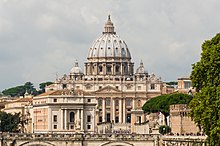
Back Oosters-Katolieke Kerke Afrikaans Ilesia Grecocatolica AN الكنائس الكاثوليكية الشرقية Arabic ليستة الكنايس الكاتوليكيه الشرقيه ARZ Ilesies católiques orientales AST Şərqi Katolik Kilsələri Azerbaijani Усходнія каталіцкія цэрквы Byelorussian Усходнія каталіцкія цэрквы BE-X-OLD Източнокатолически църкви Bulgarian Esglésies Catòliques Orientals Catalan
| Eastern Catholic Churches | |
|---|---|
Clockwise from top: St. George's Ukrainian Greek Catholic Cathedral, Melkite Greek Catholic Patriarchal Cathedral of the Dormition of Our Lady, Kidane Mehret Eritrean Catholic Cathedral, Armenian Catholic Cathedral of Saint Elias and Saint Gregory the Illuminator, St. Mary's Syro-Malankara Catholic Cathedral, Syro-Malabar Catholic Basilica of Our Lady of Dolours | |
| Classification | Catholic |
| Orientation | Eastern Christianity |
| Scripture | Bible (Septuagint, Peshitta) |
| Theology | Catholic theology and Eastern theology |
| Polity | Episcopal |
| Structure | Communion |
| Supreme Pontiff | Pope Francis |
| Language | Koine Greek, Syriac, Hebrew, Aramaic, Geʽez, Coptic, Classical Armenian, Church Slavonic, Arabic, and vernaculars (Albanian, Hungarian, Romanian, Georgian, Malayalam, etc.) |
| Liturgy | Eastern Catholic liturgy |
| Separated from | Various autocephalous churches of the Eastern Orthodox, Oriental Orthodox, and Church of the East throughout the centuries |
| Members | 18 million[1] |
| Part of a series on |
| Particular churches sui iuris of the Catholic Church |
|---|
| Particular churches are grouped by liturgical rite |
| Alexandrian Rite |
| Armenian Rite |
| Byzantine Rite |
| East Syriac Rite |
| Latin liturgical rites |
| West Syriac Rite |
|
Eastern Catholic Churches Eastern Catholic liturgy |
| Part of a series on the |
| Catholic Church |
|---|
 |
| Overview |
|
|
| Part of a series on |
| Christianity |
|---|
 |
The Eastern Catholic Churches or Oriental Catholic Churches, also called the Eastern-Rite Catholic Churches, Eastern Rite Catholicism, or simply the Eastern Churches,[a] are 23 Eastern Christian autonomous (sui iuris) particular churches of the Catholic Church in full communion with the pope in Rome. Although they are distinct theologically, liturgically, and historically from the Latin Church, they are all in full communion with it and with each other. Eastern Catholics are a minority within the Catholic Church; of the 1.3 billion Catholics in communion with the pope, approximately 18 million are members of the eastern churches. The largest numbers of Eastern Catholics are found in Eastern Europe, Eastern Africa, the Middle East, and India. As of 2022, the Syro-Malabar Church is the largest Eastern Catholic Church, followed by the Ukrainian Greek Catholic Church.[2]
With the exception of the Maronite Church, the Eastern Catholic Churches are groups that, at different points in the past, used to belong to the Eastern Orthodox Church, the Oriental Orthodox churches, or the Church of the East; these churches underwent various schisms through history. Eastern Catholic Churches that were formerly part of other communions have been points of controversy in ecumenical relations with the Eastern Orthodox and other non-Catholic churches. The five historic liturgical traditions of Eastern Christianity, namely the Alexandrian Rite, the Armenian Rite, the Byzantine Rite, the East Syriac Rite, and the West Syriac Rite, are all represented within Eastern Catholic liturgy.[3] On occasion, this leads to a conflation of the liturgical word "rite" and the institutional word "church".[4] Some Eastern Catholic jurisdictions admit members of churches not in communion with Rome to the Eucharist and the other sacraments.[b]
Full communion with the bishop of Rome constitutes mutual sacramental sharing between the Eastern Catholic Churches and the Latin Church and the recognition of papal supremacy. Provisions within the 1983 Latin canon law and the 1990 Code of Canons of the Eastern Churches govern the relationship between the Eastern and Latin Churches. Historically, pressure to conform to the norms of the Western Christianity practiced by the majority Latin Church led to a degree of encroachment (Latinization) on some of the Eastern Catholic traditions. The Second Vatican Council document, Orientalium Ecclesiarum, built on previous reforms to reaffirm the right of Eastern Catholics to maintain their distinct practices.[6]
The 1990 Code of Canons of the Eastern Churches was the first codified body of canon law governing the Eastern Catholic Churches collectively,[7] although each church also has its own internal canons and laws on top of this. Members of Eastern Catholic churches are obliged to follow the norms of their particular church regarding celebration of church feasts, marriage, and other customs. Notable distinct norms include many Eastern Catholic Churches regularly allowing the ordination of married men to the priesthood (although not as bishops to the episcopacy), in contrast to the stricter clerical celibacy of Latin Church. Both Latin and Eastern Catholics may freely attend a Catholic liturgy celebrated in any rite.[8]
- ^ "The beautiful witness of the Eastern Catholic Churches". Catholic Herald. 7 March 2019. Archived from the original on 29 September 2019. Retrieved 29 September 2019.
- ^ Cite error: The named reference
:0was invoked but never defined (see the help page). - ^ Yurkus, Kevin (August 2005). "The Other Catholics: A Short Guide to the Eastern Catholic Churches". Archived from the original on 2019-08-25. Retrieved 2019-10-03.
- ^ LaBanca, Nicholas (January 2019). "The Other Catholics: A Short Guide to the Eastern Catholic Churches-The Other 23 Catholic Churches and Why They Exist". Ascension Press. Retrieved 2019-10-04.
- ^ CCEO canon 671 §3; Archived November 30, 2012, at the Wayback Machine cf. 1983 CIC canon 844 §3 Archived December 21, 2015, at the Wayback Machine
- ^ Parry, Ken; David Melling, eds. (1999). The Blackwell Dictionary of Eastern Christianity. Malden, MA: Blackwell Publishing. ISBN 0-631-23203-6.
- ^ "Master Page on Eastern Canon Law (1990)". www.canonlaw.info. Retrieved 2022-09-04.
- ^ Caridi, Cathy (April 5, 2018). "Becoming (Or at Least Marrying) an Eastern Catholic". Canon Law Made Easy.
Cite error: There are <ref group=lower-alpha> tags or {{efn}} templates on this page, but the references will not show without a {{reflist|group=lower-alpha}} template or {{notelist}} template (see the help page).





